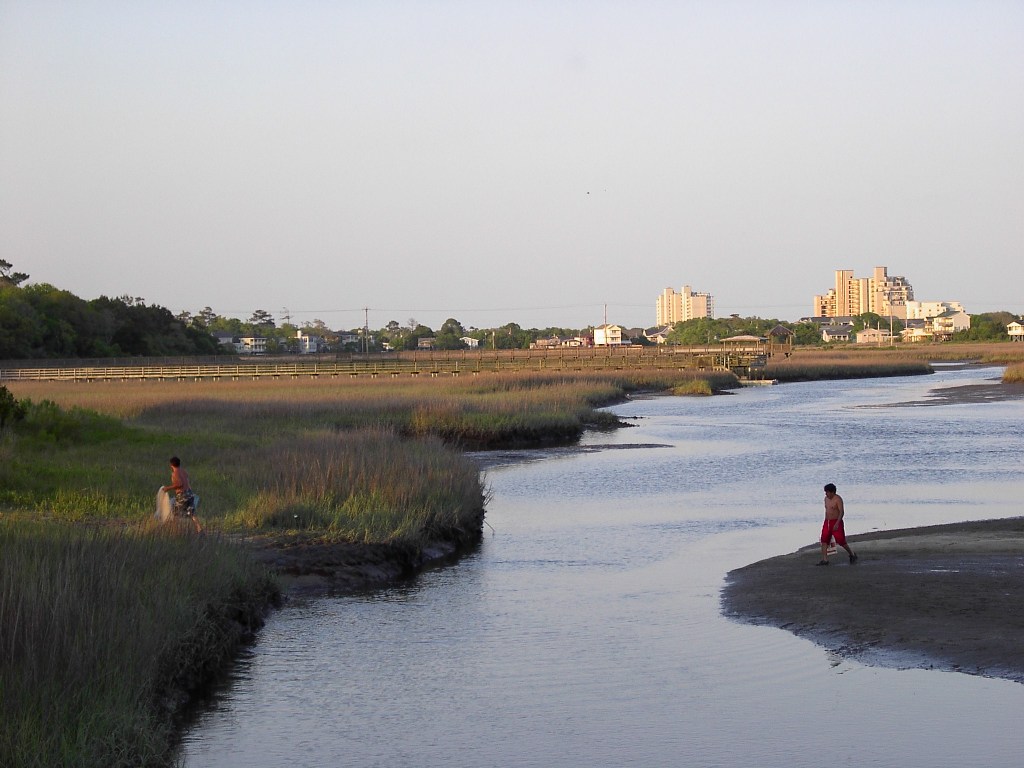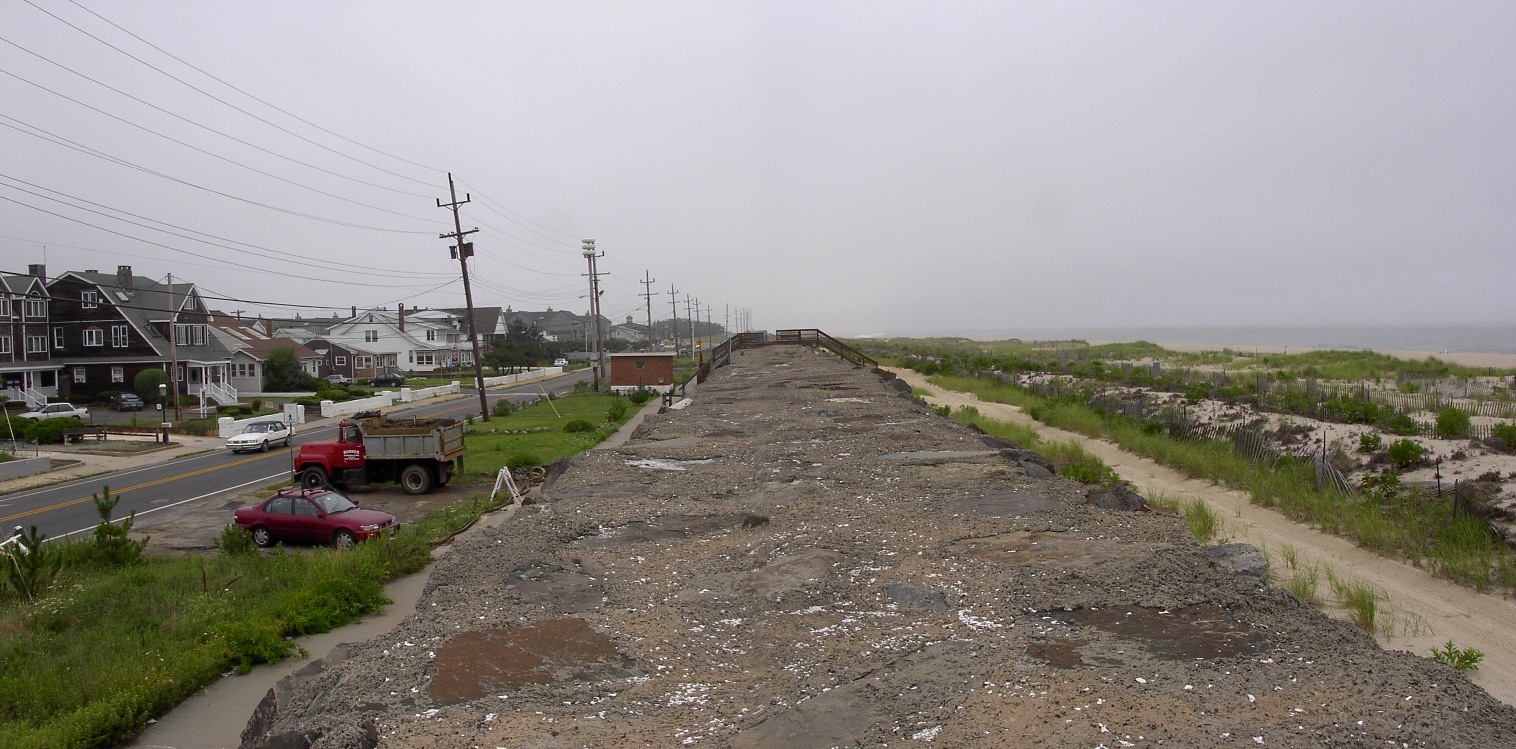- Causes of Future Sea Level Rise
- Elevation Maps
- Will we really lose all that land?
- Sea Level Rise Planning Maps
CHAPTER 5
ADVANTAGES AND DISADVANTAGES OF ROLLING EASEMENTS
The academic literature on responses to sea level rise has been relatively enthusiastic[434] about rolling easements because they are likely to cost society less than other ways to ensure that wetlands and beaches migrate inland.[435] Actual implementation of the concept, however, depends on the perceptions of property owners, developers, land trusts, and regulatory agencies. For voluntary measures, both sides of the transaction have to view it as beneficial—or at least not objectionable. For regulatory measures, if either the public or a class of property owners views the approach as harmful, it may be politically impractical. In this chapter we examine the advantages and disadvantages of rolling easements for the community at large (Section 5.1) and the owners of coastal lands that would eventually give way to the rising sea (Section 5.2).

|

|

|
Photo 22 and 23. Two Views of House Encroaching Seaward of the Vegetation Line along the Texas Gulf Coast. Surfside, Texas (May 2003). The beach was the primary means of access. Although these homes were subject to removal orders, the state did not actively seek removal. The homes were destroyed by Hurricane Ike in 2008. [Photo source: ©James G. Titus, used by permission]. |
The advantages to the environment and community of a rolling easement depend on whether the land would otherwise (Section 5.1.1) be protected or (Section 5.1.2) be given up to the rising sea, as well as the procedures for implementing such policies. In many cases, it is impossible to be sure today what would happen without a rolling easement. Given that we do not know what the future would otherwise hold, it may be useful to consider all of the possible outcomes, and then evaluate whether the expected outcome from a rolling easement is preferable to the range of possibilities without a rolling easement.
5.1.1 If Shore Protection is Expected Otherwise
If the land would otherwise be protected, then rolling easements can help a community to:
- Enable shoreline habitats to adapt naturally to the rising sea, sustaining wetlands, beaches, and species that depend on them for survival (see Photos 25 to 27);
- Avoid increased taxes to pay for elevating infrastructure or dikes with pumping systems;
- Avoid loss of waterfront views caused by a dike or seawall (see Photo 28), or the loss of access for launching small boats from the shore;
- Mitigate eventual intra-community fights about whether to protect certain vulnerable areas, because a plan is negotiated when the consequences are far enough in the future for people to be reasonable; [436]
- Avoid hazardous habitation of lands below sea level;
- Reduce flood insurance rates if the National Flood Insurance Program community rating system gives community credit for planning for sea level rise;[437] and
- Promote community awareness and dialogue about long-term sea level rise.
The resulting disadvantages include:
- Initial costs of obtaining rolling easements and continuing costs of inspecting and managing them;
- Costs associated with relocating homes or abandoning them and finding new homes;
- Non-economic costs of relocation;[438]
- The need to resist political pressure to abandon the retreat policy; and
- Litigation costs when owners attempt to avoid the terms of the rolling easement.
5.1.2 If Retreat Will Occur with or without a Rolling
Easement
If the land will otherwise be given up to the rising sea, the advantages and disadvantages depend on whether the area would be developed and later abandoned, or simply remain undeveloped.
If the land will otherwise be kept undeveloped solely because of future shoreline change,[439] a rolling easement policy can help the community to:
- Avoid having to choose between
- A large-scale purchase of expensive coastal lands or
- Constitutional takings challenges (some of which may be successful) and continual efforts by landowners and their allies to repeal or obtain exceptions to the no-development policy;
- Avoid having to pick a particular elevation (or distance from the shore) for a setback line inland of which development will be allowed (creating problems if and when the shore retreats to that point);
- Maintain the property tax base until the land is submerged, by allowing the land to become developed; and
- Enable more people to live within walking distance of the shore rather than having to drive or enjoy the shore less often.
The possible disadvantages of rolling easements compared with preventing development include all of the disadvantages listed in Section 5.1.1 (costs of managing the easement, relocation, moving, and lost buildings) as well as one other important disadvantage: Some governments may eventually decide to relax rolling easement regulations. And some landowners may challenge recorded rolling easements in court rather than acquiesce in the submergence of their homes. Although a well-drafted rolling easement would survive legal challenge, land trusts may have to spend considerable resources defending them (unless they are drafted to ensure that the landowner pays all of the costs of any unsuccessful legal challenges). By contrast, if development is prevented, shore protection will be very unlikely.
Another possible disadvantage is that the initial cost to a local government of obtaining rolling easements may be greater than the initial cost of preventing development. In some cases the only way to obtain rolling easements would be to purchase them, while regulations preventing development in the low-lying lands could be accomplished without a constitutional taking of land requiring compensation. In such cases, the total social cost to the community would still be greater for preventing development than for a rolling easement, because the landowner who loses the benefits of the development is also part of the community. But if a locality's budget is constrained, it may prefer to achieve a given objective with the least expenditure of its own funds (and regulate) rather than spend more public funds to adopt a policy with a lower total social cost (purchase rolling easements).[440]
If the land will otherwise be developed but later abandoned to the rising sea, a rolling easement can:
- Diminish eventual intra-community fights about whether to protect certain vulnerable areas because a plan and legal requirements will already be in place;
- Reduce unexpected losses from economic and emotional investments in properties that are unexpectedly abandoned by owners who were planning to remain for a long time;
- Avoid the hazards associated with substandard shore protection that subsequently fails (see Photo 29), and the human toll from an unexpected community abandonment;[441]
- Lower flood insurance rates if the National Flood Insurance Program community rating system gives the community credit for planning for sea level rise;[442]
- Promote community awareness and dialogue about long-term sea level rise; and
- Enable a community to avoid having to choose between:
- a large-scale buyout of land and structures, or
- the political and legal challenges associated with ordering people to abandon homes in which they wish to stay (which may require a buyout as well).
There are relatively few disadvantages to adopting a rolling easement policy for those areas which, in the absence of a rolling easement, would still be developed and abandoned—other than the short-term administrative cost of choosing the policy now instead of later. With or without rolling easements, land will be developed, and later the structures will be removed. The only difference is that with rolling easements, people have decades of notice that the land will be abandoned. With this eventuality, rolling easements decrease (but do not eliminate) intra-community conflict about the retreat policy, costs associated with removing structures, and losses of community infrastructure.

|
Photo 28. Dikes and Seawalls Can Block Views of the Beach and the Water. Sea Bright, New Jersey (August 2003). Photo source: ©James G. Titus, used by permission. |

|
Photo 29. Living Below Sea Level Can Be Hazardous if Shore Protection Fails. Downtown New Orleans after the failure of dikes along the Industrial Canal. (Aerial view from a U.S. Navy helicopter. August 31, 2005. |
[434] See, e.g., IPCC, supra note 110,
at 368–369; U.S. Global Change Research
Program, supra note 110,
at 87; Caldwell &
Segall, supra note 159;
Donna McMahon, The Republic of George's Island: One
Man against the Elements, 442 Nature 222 (2006); Megan Higgins,
Sea Level Rise Impacts on
Beaches and Coastal Property, 1 Sea Grant L. & Pol'y
J. 43, 51 (2008); and Mark Stallworthy, Sustainability, Coastal Erosion and Climate Change: An Environmental
Justice Analysis, 18 J. Environmental Law
357–373 (2006).
[436] Cf.
generally, John Rawls, A Theory of Justice.
(1971).
[437]
“The CRS has been developed to provide incentives for communities to go beyond
the minimum floodplain management requirements to develop extra measures to
provide protection from flooding.” National Flood Insurance Program, Flood
Insurance Manual CRS-1 (May
2005).
[438]
The human toll from relocation depends partly on whether it is well planned or
occurs unexpectedly. Gradual abandonment can cause blight. “If homes are destroyed during a storm, communities can be
severely disrupted by the sudden absence of neighbors who previously
contributed to the local economy and sense of community. People forced to
relocate after disasters are often at increased risk to both health problems and
depression.” CCSP, supra note
3,
at 100 (references omitted).
[439] If the land is
certain to remain undeveloped, the retreat pathway is likely with or without
rolling easements along most parts of the U.S. coast. See Environmental Research Letters, supra note 14.
[440] Supreme Court
holdings on the takings clause have generally been designed to discourage the
government from pursuing social goals by singling out a few property owners to
pay the cost of achieving public purposes that could more reasonably be achieved
by spending government funds and sharing the burden among all taxpayers. Dolan
v. City of Tigard, 512 U.S. 374,
396 (1994). Regulations that
generally benefit most or all property owners provide a reciprocal advantage to
all. See generally Armstrong v. United
States, 364 U.S. 40, 48 (1960). Abraham Bell & Gideon Parchomovsky, Takings Reassessed, 87 Va. L. Rev. 277, 278 (2001)
(explaining that
courts and scholars
have struggled to draw a principled boundary between valid exercises of the
police power and regulatory takings); Nollan/Dolan? Andrew W. Schwartz, Reciprocity of Advantage: The Antidote to
the Antidemocratic Trend in Regulatory Takings, 22 UCLA J. Envtl. L. & Pol'y 1 (2003);
and Joseph L. Sax, Takings and the Police Power, 74 Yale
L.J. 36, 69 (1964). Basic nuisance law and a possible reading of Penn Central imply that
a taking is less
likely when the social benefit of a restriction is greater than the cost to the
landowner. However, the regulatory takings cases do not currently require that a
given objective be met at the least cost.
[441]
See supra note 438
[442]
See supra note 437.
This page contains a section from: James G. Titus, Rolling Easements, U.S. Environmental Protection Agency. EPA‑430‑R‑11‑001 (2011). The report was originally published by EPA's Climate Ready Estuary Program in June 2011. The full report (PDF, 176 pp., 7 MB) is also available from the EPA web site.
For additional reports focused on the implications of rising sea level, go to Sea Level Rise Reports.

 4.2 Can the property right be transferred?
4.2 Can the property right be transferred? 